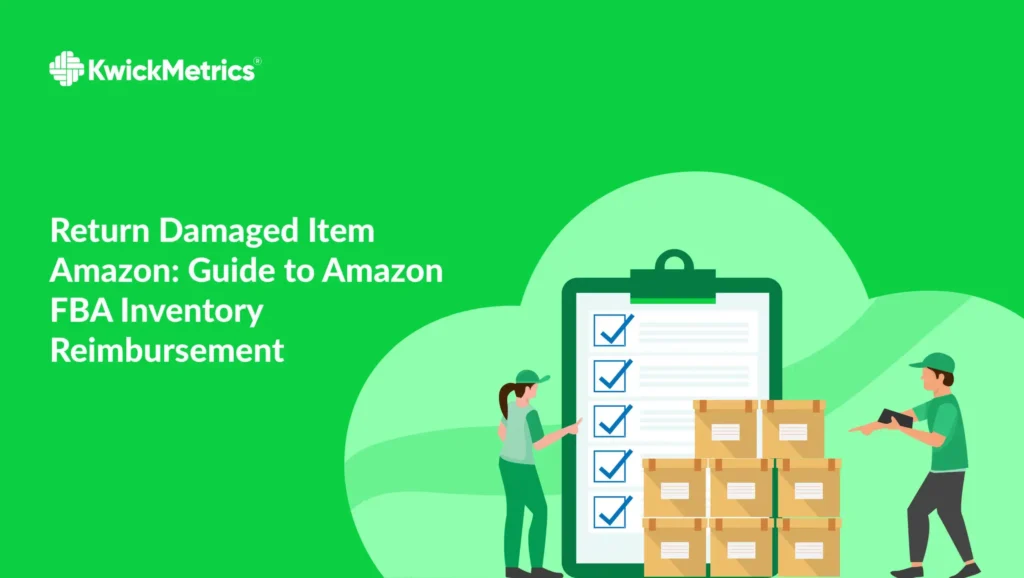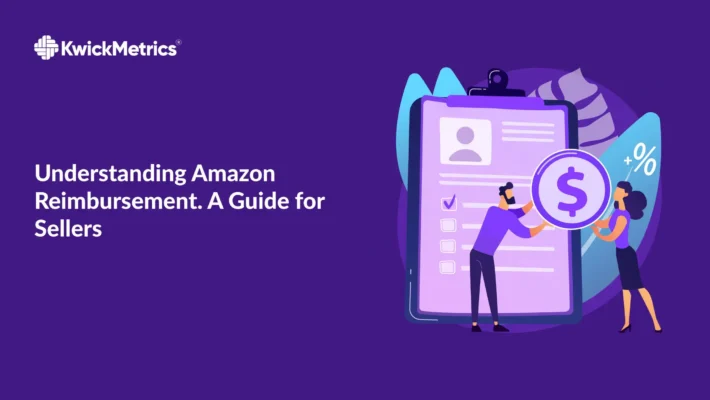Return Damaged Item Amazon: Guide to FBA Inventory Reimbursement

Table of Contents
- What is Amazon Damaged FBA Inventory Reimbursement?
- Why Amazon FBA Damaged Inventory Occurs?
- Check How Much Money You Deserve to Get Back!
- What are the Eligibility Criteria for Damaged Inventory Claims:
- Preventing Amazon FBA Damaged Inventory
- Filing an Amazon Reimbursement Claim Based on Fulfillment Process
- KwickMetrics Amazon Reimbursement Service - Your Key to Maximise Profits!
- Explore Our Features!
- Amazon Damaged Item Refund
- Try our Amazon Analytics Tool with a 14-day Free Trial!
- Get your Money back with KwickMetrics!
- FAQs In relation to Return Damaged Item Amazon
- Conclusion
Discover the ins and outs of return damaged item Amazon in our comprehensive guide. Learn about eligibility criteria, common scenarios, prevention tips, and how to file Amazon Reimbursement claims for various fulfillment processes. Whether you’re a novice or seasoned seller, understanding this policy is essential for safeguarding your business.
What is Amazon Damaged FBA Inventory Reimbursement?
Amazon Damaged FBA Inventory Reimbursement is a crucial mechanism provided by Amazon Fulfilled by Amazon (FBA) program to address instances of damaged inventory encountered by sellers. Despite the seamless platform offered by FBA, unforeseen hiccups such as return damaged item Amazon can occur during fulfillment, transportation, or within Amazon’s facilities.
In such scenarios, Amazon reimbursement system serves as a vital recourse for sellers to recover the value of compromised items. Essentially, it provides sellers with a means to mitigate potential financial losses and safeguard their bottom line.
By understanding and leveraging the Amazon Damaged FBA Inventory Reimbursement process, sellers can optimize financial recovery and fortify the resilience of their Amazon business in the dynamic realm of e-commerce.
Key Takeaway:
Importance of Amazon Damaged FBA Inventory Reimbursement: Vital mechanism for sellers to recover losses from damaged inventory, ensuring financial protection.
Why Amazon FBA Damaged Inventory Occurs?
- Transportation Troubles: Items may sustain damage during transportation to Amazon fulfillment centres, making them eligible for reimbursement if the damage occurs before they are marked as “received” by Amazon. Mishandling during shipping, improper packaging, or accidents during transit can contribute to in-transit damage.
- Mishandling in Storage Facilities: Mistakes during the warehousing process can lead to damaged inventory, allowing sellers to seek reimbursement. Warehouse handling errors may include mishandling during storage, improper stacking, or failure to follow proper handling procedures.
- Returns by Customers: Occasionally, customers may return items in a damaged condition, entitling sellers to reimbursement if the returned product was received by Amazon and then damaged during their handling process. Damage during customer returns can result from inadequate packaging, mishandling during the return process, or errors in Amazon’s handling procedures.
Check How Much Money You Deserve to Get Back!
What are the Eligibility Criteria for Damaged Inventory Claims:
To qualify for Amazon Reimbursement under Amazon Damaged FBA Inventory Reimbursement Policy, sellers must adhere to specific eligibility criteria:
-
- Enrollment in FBA: The item must be enrolled in Amazon’s Fulfilment by Amazon (FBA) service at the time of the loss or damage.
-
- Compliance with FBA Requirements: Sellers must ensure compliance with FBA product requirements, restrictions, and inventory guidelines to be eligible for reimbursement.
-
- Accurate Shipping Plan Execution: Sellers must dispatch the exact items and quantities specified in the provided shipping plan to be considered for reimbursement.
-
- Non-Disposal Status: The item should not be in a pending disposal status, disposed of at the seller’s request, or due to Amazon’s discretion to qualify for reimbursement.
-
- Defect-Free Condition: The damaged return item Amazon must be free from defects and should not have been damaged by a customer to be eligible for reimbursement.
-
- Normal Selling Account Status: Sellers’ selling accounts should be in normal status when initiating a claim for damaged Amazon inventory reimbursement. These eligibility criteria ensure that sellers adhere to Amazon Reimbursement policy and guidelines, fostering fairness and transparency in the reimbursement process.
These eligibility criteria ensure that sellers adhere to Amazon Reimbursement policy and guidelines, fostering fairness and transparency in the reimbursement process.
Preventing Amazon FBA Damaged Inventory
Amazon’s Fulfilled by Amazon (FBA) program has streamlined e-commerce, but even the most efficient systems encounter challenges. To minimize the risk of damaged inventory, proactive prevention strategies are essential. Here’s how you can safeguard your inventory:
-
- Optimal Packaging: Invest in sturdy packaging materials that provide sufficient protection during transit. Choose packaging solutions designed to withstand handling and potential impacts.
-
- Proper Labeling: Ensure accurate and secure labeling for your items. Clear and visible labels help in correct handling and minimize the risk of mishaps during transportation and warehousing.
-
- Utilize FBA Label Service: Consider utilizing Amazon FBA Label Service to ensure accurate and compliant labeling. This service helps guarantee that your items are correctly labeled, reducing the chances of errors during the fulfillment process.
-
- Regular Audits: Conduct routine audits of your inventory to identify any discrepancies or potential damage. Regular inspections allow you to address issues promptly, preventing further complications and ensuring the integrity of your inventory.
-
- Thorough Documentation: Maintain meticulous records of your inventory, including the condition of items as they’re sent to Amazon. Detailed documentation serves as valuable evidence when filing Amazon Reimbursement claims for damaged inventory.
By implementing these preventive measures, sellers can minimize the occurrence of damaged inventory within the Amazon FBA system. Proactive strategies not only mitigate risks but also contribute to smoother operations and enhanced customer satisfaction.
Key Takeaway:
Prevention is Crucial: Proactive strategies such as optimal packaging and regular audits minimize the occurrence of damaged inventory.
Filing an Amazon Reimbursement Claim Based on Fulfillment Process
The process to a file a Reimbursement claim varies by where in the fulfillment process your item is lost or damaged:
- Shipment to Amazon
- FBA customer returns
- Fulfillment center operations
- Removals
Shipment to Amazon: Amazon Shipment Reimbursement
Claim Window:
- Claims must be filed within nine months after the verified date of shipment delivery to an Amazon fulfillment center or third-party facility.
- Claims submitted beyond this window are not eligible for reimbursement.
Before You Submit a Claim:
- Verify that the shipment’s contents and the number of units match the shipping plan.
- Review the Contents tab for any discrepancies between your shipping plan and what the fulfillment center received.
- Check your Amazon Reimbursement report to ensure you haven’t already been reimbursed for the lost or damaged item.
Submitting Your Claim:
- Use the Contents tab to submit a claim for lost units.
- For damaged units, open a claim through the Contact Us page in Seller Central.
Provide the following information and documents:
- Amazon shipment ID
- Proof of inventory ownership
- Proof of delivery
- Be prepared to provide additional information upon request.
Investigation and Reimbursement:
- Amazon will conduct an investigation to confirm eligibility for replacement or reimbursement.
- Only one claim per shipment is permitted; additional claims for the same shipment will be declined.
- Sellers with frequent shipping problems may undergo additional investigation and monitoring, potentially affecting Prime eligibility or future reimbursements.
KwickMetrics Amazon Reimbursement Service - Your Key to Maximise Profits!
FBA inventory reimbursement – customer return
Claim Window:
-
- Customer return claims can be filed between 60 to 120 days (starting from 23rd October 2024) after the customer refund or replacement.
- If the item isn’t returned within 60 days, Amazon may reimburse the seller after charging the customer.
Before You Submit a Claim:
-
- Check the Manage FBA Returns Reimbursement report to confirm if Amazon refunded or replaced the item.
- Review the FBA customer returns report to see if the refunded or replaced item was returned to your inventory.
- Check the Amazon Reimbursement report to ensure you haven’t already been reimbursed for the lost or damaged item.
Submitting Your Claim:
-
- Use the provided tool to check eligibility and file a claim, entering the customer order ID.
- Be prepared to provide additional details about the item if requested.
Important Notes:
-
- Amazon doesn’t accept responsibility or reimburse for items damaged by customers, subject to recall, defective, or in violation of Amazon FBA reimbursement policy.
- No reimbursements for refunded items that can’t be returned by customers, unless Amazon takes responsibility.
- Amazon won’t reimburse for any refund issued directly to a customer.
Fulfillment center operations
Claim Window:
-
- Claims for fulfillment center operations must be submitted within 18 months from the date the item was reported lost or damaged in the Inventory Ledger report.
- For amazon.com US marketplace, this timeframe has been updated to 60 days (starting from October 23, 2024).
- Claims submitted after this window are not eligible for reimbursement.
Before You Submit a Claim:
-
- Check the Inventory Ledger > Detailed view > Event type = Adjustments to confirm the date and adjustment code of the loss or damage.
- Confirm in the Manage FBA Inventory report that the lost or damaged item wasn’t found or restored to your inventory.
- Review the Amazon Reimbursements report to ensure you haven’t already been reimbursed for the lost or damaged item.
Submitting Your Claim:
-
- If the item is damaged, use the provided tool and enter the transaction item ID to check eligibility and file a Reimbursement claim.
- Be prepared to provide additional information such as the date or location of the loss or damage, including the Amazon fulfillment center ID if necessary.
Explore Our Features!
Removals
Claim Window:
-
- The claim window for items lost in transit is 14 days from the shipment creation date. And for all other removal claims such as damaged items and grading disputes, the window is 18 months and 30 days respectively from the date the shipment is delivered back.
- For amazon.com US marketplace,
- This timeframe for items lost in transit has been updated to 15 – 75 days from the shipment creation date (starting from October 23, 2024).
- For all other removal claims such as damaged items and grading disputes, the window is 60 days from the date the shipment is delivered back.
Before You Submit a Claim:
-
- Confirm the date and status of your removal orders using the Removal Order Detail report.
- Review the Removal Shipment Detail report for shipment status and tracking information.
- Check the Amazon Reimbursements report to ensure you haven’t already been reimbursed for the lost or damaged item.
Submitting Your Claim:
-
- Provide the Amazon removal order ID, shipment ID, and active tracking ID or proof of delivery for lost units.
- Include ASINs/FNSKUs and quantities affected, LPN number, and images of the affected units and their packaging.
- If filing a claim for grading disputes, explain why you disagree with Amazon’s grading of the disputed item.
- Enter the removal order ID in the provided tool to check eligibility and file a claim. Additional information may be requested during the process.
Key Takeaway:
Ensuring Compliance with Reimbursement Procedures: Strictly adhering to eligibility criteria and accurately submitting claims significantly boosts reimbursement success rates.
Amazon Damaged Item Refund
In the event of receiving damaged items through Amazon FBA, sellers are entitled to request a refund for the affected inventory. This process, known as “Amazon Damaged Item Refund,” provides sellers with a means to recover the financial value of items damaged during transportation, warehousing, or customer returns.
Amazon Damaged Item Refund Process
When sellers encounter damaged items through Amazon FBA, the refund process, offers a clear path to recovering the financial value of the affected inventory. Here’s a step-by-step guide to navigating the refund process:
Identification of Damaged Items:
Sellers should first identify the damaged items within their inventory. This may involve inspecting incoming shipments, monitoring warehouse operations, or reviewing customer return reports.
Documentation:
It’s crucial to document the damage thoroughly. Take clear photos or videos of the damaged items, capturing any visible defects or issues. Detailed documentation serves as evidence when initiating a refund claim.
Initiating the Refund Claim:
Sellers can initiate the refund claim process through the Amazon Seller Central platform. Navigate to the appropriate section for filing reimbursement claims, usually found within the “Reports” or “Help” tab.
Providing Required Information:
During the claim process, sellers will need to provide essential information such as the Amazon shipment ID, proof of inventory ownership, and proof of delivery. Be prepared to furnish additional details upon request.
Claim Review and Investigation:
Amazon will conduct an investigation into the refund claim to confirm eligibility for reimbursement. This may involve verifying the provided documentation and assessing the circumstances surrounding the damaged items.
Amazon Reimbursement:
Upon approval of the refund claim, Amazon will issue reimbursement for the financial value of the damaged items. The reimbursement amount typically reflects the original purchase price or the current market value of the items.
Monitoring and Follow-up:
Sellers should monitor the status of their refund claims and follow up as necessary. In some cases, additional information or clarification may be required to expedite the reimbursement process.
Prime Eligibility and Future Reimbursements:
Sellers with frequent shipping problems or recurring issues may undergo additional scrutiny from Amazon. This could potentially affect their Prime eligibility or future reimbursements, highlighting the importance of proactive inventory management and preventive measures.
By following these steps and leveraging the Amazon Damaged Item Refund process, sellers can effectively recover the financial losses incurred due to damaged inventory within the Amazon FBA system.
Try our Amazon Analytics Tool with a 14-day Free Trial!
Get your Money back with KwickMetrics!
Are you struggling to manage Amazon reimbursements? Let KwickMetrics simplify the process and help you earn more money effortlessly. Here’s how we can assist you:
Problems You Might Be Facing and How KwickMetrics Helps:
-
- Limited Time:
Spending hours chasing reimbursements? KwickMetrics saves you time by streamlining the process, allowing you to focus on growing your business.
- Limited Time:
-
- Missed Opportunities:
Worried about missing out on potential reimbursements due to confusion? KwickMetrics’ smart system ensures you never overlook any money owed to you.
- Missed Opportunities:
-
- Financial Worries:
Unsure if you’re getting all the money you deserve? KwickMetrics provides peace of mind by maximizing your reimbursements, easing financial concerns.
- Financial Worries:
How KwickMetrics Works?
-
- Expert Guidance:
Our dedicated KwickMetrics team of experts understands Amazon FBA system inside and out, providing you with invaluable guidance and Amazon Reimbursement service every step of the way.
- Expert Guidance:
Begin your journey to maximizing your profits today by partnering with KwickMetrics and see the difference for yourself.
FAQs In relation to Return Damaged Item Amazon
What is Amazon Damaged FBA Inventory Reimbursement?
A mechanism for FBA sellers to recover losses from damaged inventory.
Why does Amazon FBA inventory get damaged?
Mishandling during transportation, storage, or customer returns.
What are the eligibility criteria for reimbursement claims?
Enrollment in FBA, compliance with FBA requirements, accurate shipping plan execution, etc.
How can sellers prevent FBA inventory damage?
Optimal packaging, proper labeling, regular audits, and thorough documentation.
How do sellers file reimbursement claim for damaged inventory?
Initiate claims within specified windows, provide necessary documentation, and follow Amazon’s procedures.
Conclusion
In conclusion, Amazon Damaged FBA Inventory Reimbursement policy is a vital safeguard for sellers utilizing the Fulfilled by Amazon (FBA) program. It provides a means to recover losses incurred due to damaged inventory during transportation, warehousing, or customer returns. By adhering to specific eligibility criteria and following the correct procedures for filing claims based on the fulfillment process, sellers can seek reimbursement for eligible items. Prevention strategies such as optimal packaging, proper labeling, regular audits, and thorough documentation can help minimize the occurrence of damaged inventory. Understanding the reimbursement process and proactively implementing preventive measures are key to optimizing financial recovery and ensuring the resilience of an Amazon business.



